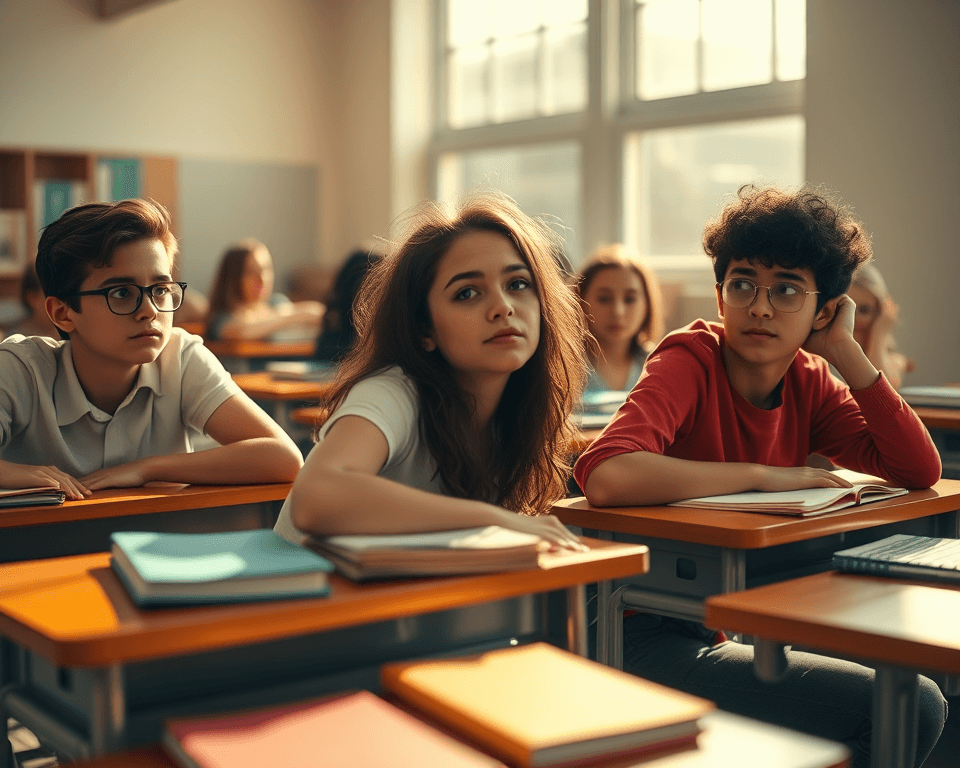Let’s kick this off by talking about classroom behavior. If you’ve ever felt like your brain’s on a rollercoaster during class, bouncing around between thoughts of lunch, that new game, and the math test you forgot to study for, you’re not alone! We all want to ace our classes, stay engaged, and avoid being the kid that’s always getting side-eyes from the teacher. So let’s get into some straightforward, no-nonsense tips that’ll help you step up your classroom game without losing your mind in the process.
Key Takeaways
- Understand your emotional triggers to manage classroom stress better.
- Integrate mindfulness techniques to improve focus and reduce anxiety.
- Set clear, achievable behavior goals to track progress.
- Use positive reinforcement to motivate yourself and others.
- Foster supportive relationships with peers for a more enriching classroom experience.
Understand Your Triggers
Let’s start with something super important: understanding your emotional triggers. Everyone has those moments when they feel overwhelmed, but figuring out what makes you tick is crucial. I remember sitting in class, mind racing, and suddenly feeling jittery. It wasn’t just the math that stressed me out; it was the two-hour nap I didn’t take earlier—or that last-minute homework I forgot.
Strategies to Recognize Emotional Triggers
Being aware of your emotions can turn a challenging day into a manageable one. Start with some self-reflection: think about the times you felt distracted or anxious. Was it a particular subject? Maybe it was when the teacher called on you unexpectedly. Take notes on these situations. Developing emotional awareness allows you to spot when your feelings start affecting your schoolwork.
Here’s a trick: try setting aside a few minutes each day to assess how you felt during classes. Note what triggered that feeling. Was it the group work? The teacher’s pace? By honing in on these insights, you can tailor your approaches to lessen those emotional spikes.
Real-life Examples of Trigger Management
I had a buddy who was practically glued to his phone during history class—totally disengaged. One day, he realized that the lectures dragged on because he didn’t get involved. He decided to take notes on his phone but made a rule not to check social media during the hour. Lo and behold, paying attention transformed his day. Not only did he improve his grades, but he also found a rhythm that made history not-so-boring.
“Understanding what drives my distractions made all the difference. Sometimes, it was just wanting to fit in or avoiding an embarrassing question. But knowing helped with my stress.”
Develop Mindfulness Techniques
Here’s another thing I found super helpful: integrating mindfulness techniques into my day. This isn’t just about sitting cross-legged and chanting. Mindfulness can be as simple as focusing on your breath for a few moments when that sudden wave of stress hits.
Incorporating Mindfulness in Daily Class Routine
Think about it—a couple of deep breaths before a big presentation can ground your anxiety. Start each class with a short breathing exercise. There’s this awesome app called Headspace (they have a free trial, by the way), which has guided sessions that can fit into your breaks between classes.
Mindfulness doesn’t just help you chill; it can actually boost your attention span. A study from Harvard pointed out that practicing mindfulness increases your ability to focus during lectures, enriching your comprehension and retention.
Successful Mindfulness Strategies from Other Students
I’ve seen some of my classmates using mindfulness techniques in creative ways. One sent a yoga video link in our group chat and led a brief session before finals. I was skeptical, but it worked! Just a quick stretch and focus moment can turn anxiety into clarity.
“Incorporating mindfulness in my day-to-day has made my class experiences so much richer. I feel present!”
Set Personal Behavior Goals
Let’s get into setting some positive behavior goals. It’s like creating a roadmap for your success! The idea here is to identify what you want to achieve in terms of behavior and stick to it.
How to Create Achievable Behavior Goals
I’m all about those SMART goals—Specific, Measurable, Achievable, Relevant, and Time-bound. For instance, instead of saying, “I’ll be better in class,” reframe it to: “I will raise my hand at least once every class this month.” That’s a goal you can actually measure!
Writing it down is key. Grab a planner or an app like Todoist to track progress. Set reminders on your phone, too. No one wants to be the student who forgot about their commitments because their phone was buried under a sea of snacks.
Examples of Behavior Goals to Inspire You
Consider these goals:
– Engaging more during class: Try asking at least one question per class for a week.
– Improving respect towards others: Commit to listening without interrupting for the next month.
– Enhancing focus: Reduce phone usage during lectures, aiming for an hour of undistracted time.
Small changes snowball into big results. It’s like leveling up in your favorite game—those little wins add up to something significant!
Use Positive Reinforcement
Let’s talk about motivation. Positive reinforcement can go a long way. It’s all about rewarding yourself for those little victories.
Strategies for Implementing Positive Reinforcement
When I got my first A in math, I treated myself to a nice lunch at Chipotle. Rewards don’t have to be expensive. It could be giving yourself an hour of Netflix time after finishing that notoriously dull reading.
Find a system that resonates with you. It could be a sticker chart, where each completed assignment earns you a sticker. Once you hit ten? Treat yourself to a movie night.
Success Stories of Positive Reinforcement in Action
I knew this one guy who struggled with science. He was rewarded with extra video game time for each quiz he aced. By the end of the year, he was not only passing but thriving. It’s all about finding the rewards that motivate you.
“At first, I was skeptical about rewards, but after witnessing my friend’s transformation, I realized – it’s all about what drives you!”
Engage in Reflective Learning
This one isn’t just buzzword fluff. Reflective learning is an essential tool to understand your actions and grow from them. It’s about looking back to move forward.
Techniques for Effective Reflection on Behavior
Grab a journal or a note-taking app—whatever suits you. After class or at the end of your day, jot down what went well and what didn’t. Reflect on your goals too. Did you raise your hand? How did that feel? Learning from these moments can guide your future actions.
Real-Life Accounts of Reflective Learning Improvement
I started keeping a journal last year, and it’s amazing how much I learned from it. I’d write about my reactions during group projects—especially when tensions flared. By reflecting on my feelings, I could see patterns and adjust my behavior accordingly.
Regularly checking in with myself helped me break the ice with classmates I initially avoided because I misread their intentions.
Build Strong Peer Relationships
Next up, let’s discuss peer relationships. You ever feel out of place in a group project? Fostering strong connections with classmates can alleviate a lot of stress and enrich your school life.
Tips for Fostering Positive Relationships with Classmates
Start by saying hi, or making small talk. Believe it or not, complimenting someone’s shoes can break the ice! It’s all about those little gestures. Engage in group study sessions and don’t shy away from collaborating on assignments.
When you build rapport, it turns group projects from something you dread into an enjoyable experience.
Examples of Students Who Improved Behavior Through Peer Support
I’ve seen students make huge strides just by forming study groups. There’s one group I know that turned their grades around by coming together before tests. They shared insights and supported one another.
By building this support system, they felt empowered—like they weren’t alone in challenging classes.
Manage Classroom Distractions
Now, let’s tackle distractions. They’re everywhere, especially in class. From chatter to phone buzzes, you have to find ways to minimize those interruptions.
Techniques for Staying Focused in Class
When distractions start to creep in, focus on the lesson. One technique I found helpful was to take notes by hand instead of typing. There’s something about the physical act of writing that keeps me engaged.
Find tools that work for you. Apps like Forest help you stay focused by planting trees while you stay off your phone. Trust me, it’s a game changer for focus!
Real Stories of Overcoming Distractions
I had a friend who used to get distracted by his phone constantly. He started putting his phone in his backpack during class. He also set screen time limits for games. His grades soared, alongside his focus. Ever since, he’s been a classroom champ!
Ask for Teacher Support
Don’t hesitate to reach out for help. Seriously! Teachers are there for a reason, and most genuinely want to see you succeed.
Strategies for Effectively Communicating with Teachers
When you approach your teacher, be respectful. Start by asking a question related to the topic. If you’re struggling, let them know! Most educators would love to help. Send them an email, or catch them before or after class. It doesn’t have to be scary.
Case Studies of Students Who Sought Help
I know a girl who was struggling in English and sought help from her teacher. After a couple of meetings, they developed a plan together that boosted not only her grades but her confidence too. It’s empowering to advocate for yourself!
Stay Organized
Let’s face it: chaos breeds stress. When your workspace is a mess, it can be hard to focus. Organization is key to maintaining that calm and keeping on top of your game.
Tools and Techniques for Staying Organized
Invest in a good planner or use productivity apps like Notion or Trello. These tools can help you keep track of assignments, due dates, and personal goals.
I swear by color-coding my notes and schedules. It makes everything visually appealing and easy to follow. Once you get your systems in place, it feels great.
Stories of Students Who Improved Through Organization
There’s this one student I know who struggled with organizing her notes. Once she started using a planner and took ten minutes each day to fill it out, her stress levels dropped, and her grades went up. She now swears by it!
Embrace Growth Mindset
Finally, let’s discuss the power of a growth mindset. Accepting that you can always improve transforms setbacks into opportunities. Embrace the idea that every challenge is a chance to learn and get better.
Tips for Developing a Growth Mindset in Class
Start by changing your inner dialogue. Instead of “I can’t do this,” tell yourself, “I can learn this.” Reward your efforts instead of just focusing on outcomes. When you take risks, celebrate those attempts.
Inspirational Stories of Growth Mindset Realizations
I once heard about a kid who failed his math test. But instead of giving up, he used that experience to work harder. He started looking for tutoring, asked questions, and gradually improved. By the end of the year, he was one of the top performers.
“I realized that setbacks are just setups for comebacks. Every failure taught me something I needed to move forward.”
I hope you’ve picked up some solid strategies to improve your classroom behavior today. Remember, it’s about embracing who you are and turning your experiences into tools for growth. Now go out there, put some of these tips into action, and make your classroom experience the best it can be!
Frequently Asked Questions
How can understanding my triggers improve my classroom behavior?
Understanding your triggers enhances emotional awareness and helps you manage stress effectively. By identifying specific situations or events that lead to negative reactions, you can develop strategies, such as mindfulness, to respond more positively in classroom settings.
What mindfulness techniques can I easily integrate into my daily class routine?
Simple mindfulness techniques include deep breathing exercises, brief moments of meditation, or engaging in focused attention activities. You can also encourage “mindful moments” where students pause to reflect on their feelings, helping to create a calmer classroom environment.
What should I consider when setting personal behavior goals?
When setting personal behavior goals, aim for SMART objectives: Specific, Measurable, Achievable, Relevant, and Time-bound. This approach ensures your goals are clear and realistic, allowing for better tracking of your progress and increased motivation for self-improvement.
How can positive reinforcement benefit students in the classroom?
Positive reinforcement encourages desirable behaviors by rewarding students for their achievements. This strategy boosts motivation and fosters a supportive classroom atmosphere, making students more likely to engage positively with their peers and educators.
What types of reflective learning practices can I implement to improve my behavior?
Reflective learning practices include journaling about daily experiences, seeking peer feedback, and engaging in self-assessment exercises. These techniques encourage personal insights and growth, helping you identify areas for behavior improvement and fostering a proactive mindset.
How can I navigate distractions effectively in a busy classroom?
To manage distractions, create a personal focus plan that includes techniques like seating arrangement adjustments, use of focus-enhancing tools, and regular check-ins with yourself to maintain attention. Communicating with teachers about your needs can also help minimize disruptions.
What are some effective ways to communicate with teachers for support?
Effective communication involves being respectful and approaching your teachers with clear, specific questions or concerns. Practicing active listening and coming prepared for discussions can help foster a positive relationship while ensuring you receive the support you need.
How can staying organized help improve my classroom behavior?
Staying organized allows you to manage your time and tasks more effectively, reducing stress and anxiety. Using tools like planners or digital apps helps you prioritize assignments, leading to better focus in class and improved overall behavior.
What does developing a growth mindset entail in an educational setting?
Developing a growth mindset involves fostering resilience and the belief that abilities can improve through effort and learning. This can be encouraged through positive affirmations, embracing challenges, and learning from feedback, which can significantly impact classroom performance.
How can peer relationships influence student behavior in the classroom?
Strong peer relationships foster positive communication and support among classmates. Engaging in collaborative activities and encouraging friendships can lead to an inclusive environment that promotes better behavior, as students feel more comfortable and supported in their social interactions.










